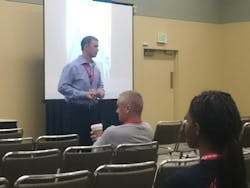FHExpo: Anderson Urges Aggressive Intelligence-Gathering in Fire Districts
During his Thursday morning Firehouse Expo session “Tactical Intelligence: Planning for Efficiency and Survival,” Philadelphia Firefighter Tim Anderson underscored the benefits gained through aggressive intelligence-gathering in your response area. He then offered steps to maximize the tactical advantages.
Anderson started by offering a simple definition of tactical intelligence: “Intelligence that supports the planning and conduct of tactical actions.” Applied to the fire service, it comes down to using the knowledge you gain studying your fire districts to better predict where, when and why a fire will happen.
Anderson explained that many departments rely solely on Target Hazard Planning, which is usually focused on big or usual response types, often involving hazmat facilities or the tallest building in the area, for example. He argued that firefighters should focus their planning beyond these “big” events. Planning must also focus on the structures that have a high likelihood of having an incident—a concept he calls Predicted Hazard Planning.
Anderson described several “predicted hazard” indicators:
- Vacant structures
- Buildings under construction
- Unconventional occupancies
- Electrical hazards
- Previous fires
- Crime
- Gut feeling
Anderson explained that firefighters should be aware of the buildings or areas in their fire districts where these indicators are present. Buildings under construction, for example, are often the site of fires because there are several ignition sources and often a lack of fire protection sources. Firefighters should also take note of illegal electrical hookups they see outside structures, as this could be a clue as to what’s happening inside. When it comes to the “gut feeling,” Anderson said it’s not uncommon to visit a structure where something just doesn’t feel right, compelling you to revisit for further instruction. Don’t ignore those instincts.
The predicted hazard indicators pose significant operational limitations for firefighters. Although the specific limitations will vary district to district, Anderson offered several examples:
- Forcible entry problems
- Aggressive reinforcement
- Unexpected locking mechanisms
- Mixed building construction
Anderson urged firefighters to understand the predicted hazards in their districts so they can plan in advance how to handle these limitations. “It’s easier to plan for these issues in advance than it is at 3 a.m. with a fire,” he said.
Knowing the response area well also provides significant operational advantages. For example, knowing which buildings have exterior walk-in basements is critical to firefighter safety so the incident commander doesn’t unnecessarily send a firefighter into a basement from the top floor when there is a far safer access point.
Anderson encourages departments to follow four steps to implement the predicted hazard plan:
- Adopt: Don’t wait for a fire to happen; plan ahead.
- Observe: Make the time to go into the community and observe the area.
- Report: Take what you learn and report back to the appropriate level.
- Plan: Be flexible with your plans and remember, “We make a plan so we have something to deviate from.”
In short, Anderson says, the more effort you put into studying your district, the greater your chances for a well executed fire attack and surviving the encounter.
About the Author

Janelle Foskett
Janelle Foskett served as editorial director of Firehouse Magazine and Firehouse.com, overseeing the editorial operations for the print edition along with working closely with the Web team.
